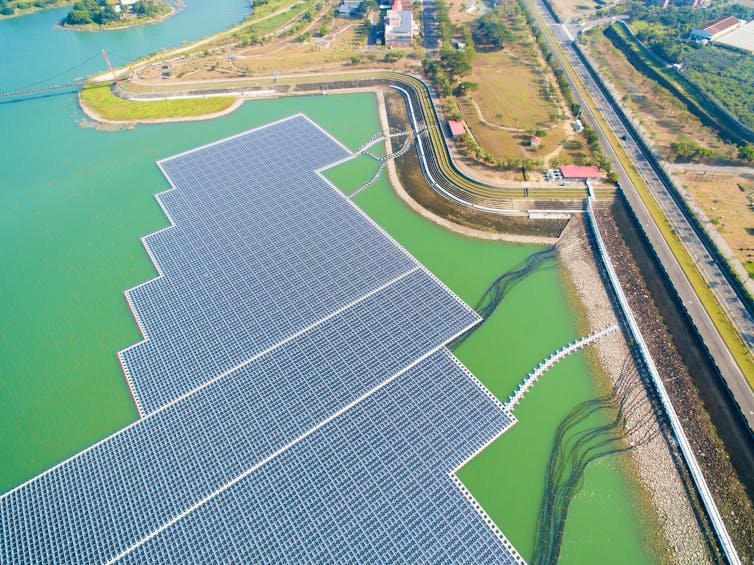Five ways to make cities more resilient to climate change
Climate breakdown poses immense threats to global economies, societies and ecosystems. Adapting to these impacts is urgent. But many cities and countries remain chronically unprepared in what the UN calls an “adaptation gap”.
Building climate resilience is notoriously difficult. Economic barriers limit investment in infrastructure and technology. Social inequities undermine the capacity of vulnerable populations to adapt. And inconsistent policies impede coordinated efforts across sectors and at scale.
My research looks at how cities can better cope with climate change. I have identified five ways to catalyse more effective – and ultimately more progressive – climate adaptation and resilience.
1. Don’t just ‘bounce back’ after a crisis
When wildfires, storms or floods hit, all too often governments prioritise rebuilding as rapidly as possible.
Though understandable, resilience doesn’t just entail coping with the effects of climate change. Instead of “bouncing back” to a pre-shock status, those in charge of responding need to encourage “bouncing forward”, creating places that are at less risk in the first place.
After the Christchurch earthquake in February 2011, the New Zealand authorities “built back better”, improving building codes and regulations and relocating vulnerable communities. Critics suggested reconstruction provided too much uncertainty and failed to acknowledge private property rights. But the rebuild did encourage better integration of planning policies and land use practices.

Swales and sustainable urban drainage in Gorton climate resilient park, Manchester, UK. Paul O'Hare, CC BY-NC-ND
2. Informed by risk
It can be difficult to predict what the consequences of a crisis might be. Cities are complex, interconnected places. Transboundary risks – the consequences that ripple across a place – must be taken into account.
The best climate adaptation plans recognise that vulnerability varies across places, contexts and over time. The most effective are holistic: tailored to specific locations and every aspect of society.
Assessments must also consider both climatic and non-climatic features of risk. In 2015, in the UK, a flood affected one of Lancaster’s electrical substations, causing a city-wide power failure that took several days to rectify. In this instance, as with so many others, people had to deal not just with the direct impacts of flooding, but the ‘cascading’ or knock-on impacts of infrastructure damage.
Read more: Giving rivers room to move: how rethinking flood management can benefit people and nature
Many existing assessments have limited scope. But others do acknowledge how ageing infrastructures and pressures to develop land to accommodate ever intensifying urban populations exacerbate urban flood risk. Others too, such as the recently published Cambridge climate risk plan, detail how climate risk intersects with the range of services provided by local government.
Systems thinking – an approach to problem-solving that views problems as part of wider, interconnected systems – can be applied to identify interdependencies with other drivers of change.
Good risk assessments will, for example, take note of demographics, age profiles and the socio-economic circumstances of neighbourhoods, enabling targeted support for particularly vulnerable communities. This can help ensure communities and systems adapt to evolving challenges as climate change intensifies, and as society evolves over time.
Complex though this might be, city leaders can access advice about improving risk assessments, including from the C40 network, a global coalition of 100 mayors committed to addressing climate change.
3. Transformative action
There is no such thing as a natural disaster. The effects of disasters including floods and earthquakes are influenced by pre-existing, often chronic, social and economic conditions such as poverty or poor housing.
Progressive climate resilience looks beyond the immediacy of shocks, attending to the underlying root causes of vulnerability and inequality. This ensures that society is not only better prepared to withstand adverse events in the future, but thrives in the face of uncertainty.
Progressive climate resilience therefore demands tailored responses depending on the population and place. In Bangladesh, for instance, communities are building floating gardens to grow crops during floods. These enhance food security and provide a sustainable livelihood option in flood-prone areas.

Floating vegetable gardens in Bangladesh. Mostafijur Rahman Nasim/Shutterstock
Read more: Climate change isn't fair but Tony Juniper's new book explains how a green transition could be 'just'
4. Collective approaches
Effective climate resilience demands collective action. Sometimes referred to as a “whole of society” response, this entails collaboration and shared responsibility to address the multifaceted challenges posed by a changing climate.
The most effective initiatives avoid self-protection, of people, buildings and cities alike, and consider both broader and longer-term risks. For instance, developments not at significant risk should still incorporate adaptation measures including rainwater harvesting or enhanced greening to lower a city’s climate risk profile and benefit local communities, neighbouring authorities and surrounding regions.
So, progressive resilience is connected, comprehensive and inclusive. Solidarity is key, leveraging resources to address common challenges and fostering a sense of shared purpose and mutual support.

Solar panels on the surface of a reservoir not only provide a source of renewable energy but also provide shade and therefore help conserve water. Tom Wang/Shutterstock
5. Exploiting co-benefits
The most effective resilience projects exploit co-benefits – what the UN calls “multiple resilience dividends” – to leverage additional benefits across sectors and policies, reducing vulnerability to shocks while addressing other social and environmental challenges.
In northern Europe, for example, moorlands can be restored to retain water helping alleviate downstream flooding, but also to capture carbon and provide vital habitats for biodiversity.
In south-East Asia solar panels installed on reservoirs generate renewable energy to reduce greenhouse gas emissions, while providing shade to reduce evaporation and conserve water resources during droughts.
In short, adaptation is obviously crucial for tackling climate change across the globe. But the real challenge is to deal with the impacts of climate change while simultaneously creating communities that are fairer, healthier, and better equipped to face any manner of future risks.
댓글
댓글 쓰기